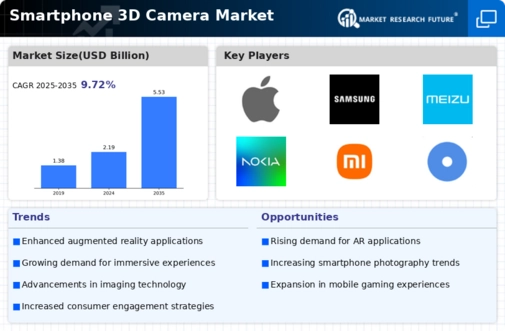Social Media Influence
The pervasive influence of social media platforms serves as a significant driver for the Global Smartphone 3D Camera Market Industry. Users increasingly share 3D images and videos, creating a demand for smartphones that offer superior 3D imaging capabilities. Platforms like Instagram and Snapchat encourage users to engage with 3D content, prompting manufacturers to enhance their camera features. This trend is likely to contribute to a compound annual growth rate (CAGR) of 8.8% from 2025 to 2035, as brands recognize the importance of catering to the social media-savvy consumer. The focus on 3D camera technology is expected to intensify as competition among smartphone brands escalates.
Technological Advancements
The Global Smartphone 3D Camera Market Industry experiences a robust growth trajectory, primarily driven by rapid technological advancements. Innovations in camera sensors, image processing algorithms, and software applications enhance the quality and functionality of 3D cameras. For instance, the integration of artificial intelligence in image processing allows for superior depth perception and object recognition. As a result, the market is projected to reach 2.19 USD Billion in 2024, reflecting a growing consumer demand for high-quality imaging solutions. This trend indicates that manufacturers are increasingly investing in R&D to develop cutting-edge 3D camera technologies, thereby expanding their market presence.
Rising Demand for Augmented Reality
The increasing popularity of augmented reality (AR) applications significantly influences the Global Smartphone 3D Camera Market Industry. As AR technology becomes more mainstream, consumers seek smartphones equipped with advanced 3D cameras that can seamlessly integrate digital content into the real world. This demand is evident in various sectors, including gaming, education, and retail, where immersive experiences are paramount. The market's growth is expected to accelerate, with projections indicating a rise to 5.53 USD Billion by 2035. Consequently, smartphone manufacturers are prioritizing the development of 3D camera capabilities to cater to this burgeoning demand, positioning themselves competitively in the evolving landscape.
Consumer Preference for High-Quality Imaging
Consumer preferences are shifting towards high-quality imaging solutions, which significantly impacts the Global Smartphone 3D Camera Market Industry. As photography becomes an integral part of daily life, users increasingly demand smartphones that deliver exceptional image quality, particularly in 3D formats. This trend is reflected in the growing sales of smartphones with advanced camera systems, which are designed to meet the expectations of photography enthusiasts. The market's expansion is anticipated to continue, with an estimated value of 2.19 USD Billion in 2024. Manufacturers are responding by incorporating advanced optical technologies and enhanced camera features, thereby aligning their products with consumer desires for superior imaging experiences.
Integration of 3D Cameras in Various Applications
The integration of 3D cameras into diverse applications propels the Global Smartphone 3D Camera Market Industry forward. Beyond traditional photography, 3D cameras are increasingly utilized in fields such as healthcare, automotive, and entertainment. For example, in healthcare, 3D imaging aids in diagnostics and surgical planning, while in automotive, it enhances safety features through advanced driver-assistance systems. This multifaceted application landscape suggests a growing recognition of the utility of 3D cameras across industries. As the market evolves, it is projected to reach 5.53 USD Billion by 2035, indicating a sustained interest in the versatility and functionality of 3D camera technology.

























Leave a Comment